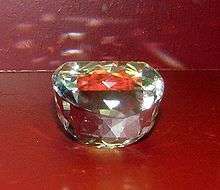Orlov (diamond)
 Copy of the Orlov Diamond. Note: It is actually turned upside-down in this photo | |
| Weight | 189.62 carats (37.924 g) |
|---|---|
| Country of origin | Kollur Mine, Guntur District, Andhra Pradesh, India |
| Owner | Kremlin Diamond Fund |
The Orlov (sometimes spelled Orloff) is a large diamond that is part of the collection of the Diamond Fund of the Moscow Kremlin. It is described as having the shape and proportions of half a chicken's egg. Mined in south India, probably at the Kollur Mine, it appears in history as far back as the 2nd century CE, when it was mounted on the idol of Sri Ranganathaswamy in Srirangam, Tamil Nadu. It was stolen in 1747 by a French soldier who had frequented the temple for many years prior to the theft, and who had been (or pretended to be) a devotee of the Lord.
This diamond should not be confused with the "Black Orlov diamond", called the Eye of Brahma, which according to legend was stolen from a temple near Pondicherry, in Puducherry, again by a French soldier.
History

The particulars of the Orlov's story have been lost with time, but it is widely reported that the diamond was mounted on the idol of the presiding deity of the Sri Ranganathaswamy Temple at Srirangam, in southern India. It served as the tilaka on the forehead of the presiding deity, before being stolen. The man held responsible for its removal was a French deserter, a grenadier from the Carnatic wars who apparently converted to the Hindu faith and worshipped at the temple for many years. Whether the deserter did this sincerely or solely to gain access to the statue is not known. The temple, situated on an island in the Cauvery River, was surrounded by seven enclosures; no Christians were permitted farther than the fourth. Once having pilfered the stone around 1750 the deserter fled to Madras[1] (now Chennai) where he would find protection with the British Army, as well as a buyer.
The as yet unnamed stone passed from merchant to merchant, eventually appearing for sale in Amsterdam. Shaffrass, an Iranian millionaire who then owned the diamond,[1] found an eager buyer in Count Grigory Grigorievich Orlov.[2] The Count paid a purported 400,000 Dutch florins.
Years before the purchase Grigory Orlov had been romantically involved with the young Catherine the Great of Russia, an affair beginning while she was Empress Consort of Russia, married to the Emperor Peter III of Russia. Their affair continued as Grigory Orlov led the way in the dethronement of her husband in a coup d'état and the elevation of Catherine to power. Their relationship carried on for many years and produced an illegitimate child, but Catherine eventually forsook Count Orlov for Grigori Alexandrovich Potemkin. Count Orlov sought to rekindle their romance by offering her the diamond, as it is said he knew she had wished for it.[3] While he failed to regain her affections, Catherine did bestow many gifts upon Count Orlov; these gifts included the Marble Palace in St. Petersburg. Catherine named the diamond after the Count, and had her jeweller, C. N. Troitinski, design a sceptre incorporating the Orlov. Now known as the Imperial Sceptre, it was completed in 1784.
Description
.jpg)
A description was given by Eric Burton in 1986:
The sceptre is a burnished shaft in three sections set with eight rings of brilliant-cut diamonds, including some of about 30 carats (6 g) each and fifteen weighing about 14 carats (2.8 g) each. The Orlov is set at the top, with its domed top facing forward. Above it is a double-headed eagle with the Arms of Russia enameled on its breast.[4]
The Orlov is a rarity among historic diamonds, for it retains its original Indian rose-style cut (see diamond cut). Its colour is widely stated as white with a faint bluish-green tinge. Data released by the Kremlin give the Orlov's measurements as 32 millimetres x 35 millimetres x 21 millimetres, its weight being 189.62 carats (37.924 g). The weight is just an estimate – it has not formally been weighed in many years. Lord Twining's book "A History of the Crown Jewels of Europe" mentions how once during a circa 1913 inspection of the crown jewels by the curator, the stone accidentally fell out of its sceptre. He weighed the stone, but did not write down its exact weight. He later said that it was about 190 carats (38 g), which corresponds to the measurement-based estimate.
References
- 1 2 Dale Hoiberg, Indu Ramchandani (2008), Students' Britannica - India, Encyclopaedia Britannica (UK) Ltd. p. 134. ISBN 0-85229-760-2
- ↑ Dixon, Simon (2010), Personality and Place in Russian Culture: Essays in Memory of Lindsey Hughes, Modern Humanities Research Assn. p. 171. ISBN 1-907322-03-5
- ↑ Malecka, Anna " Did Orlov buy the Orlov ?", Gems and Jewellery, July 2014, vol. 23, no. 6, pp. 10–12.
- ↑ Burton, E. (1986). Legendary Gems or Gems That Made History, pp. 45–47. Chilton Book Company, Radnor, PA
- Malecka, Anna (2014), "Did Orlov buy the Orlov ? ", Gems & Jewellery: The Gemmological Association of Great Britain, vol. 23 (6), July, pp. 10–12.
- Malecka, Anna (2016), The Great Mughal and the Orlov: One and the Same Diamond? The Journal of Gemmology, vol. 35, no. 1, 56-63.
- Shipley, Robert (1939). Famous Diamonds of the World, pp. 15–18. Gemological Institute of America, USA
- Twining, Lord Edward Francis (1960). A History of the Crown Jewels of Europe, B.T. Batsford Ltd., London, England.